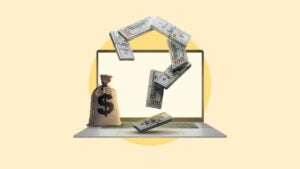How much can I borrow with a personal loan if I have bad credit?

Key takeaways
- Lenders that offer loans for bad credit may accept FICO scores as low as 560 or may not require a credit score at all.
- Every lender has different eligibility requirements and maximum loan amounts.
- Upstart, Avant and LendingPoint are three of the best lenders for poor credit due to their lending models, APR ranges and repayment terms.
Many lenders offer personal loans between $1,000 and $50,000. If your credit is poor, the amount you qualify for will depend on multiple factors.
You may also face higher rates with a bad credit loan, which can make your monthly payment pricey. That said, there are lenders that will work with you regardless of your credit history — but it might limit the amount you are eligible to borrow.
Factors that affect loan amount
The lower your credit score, the less likely you are to qualify for a lender’s highest advertised loan amount. However, lenders may still consider you based on your credit history, your current debts and your income to determine how much you can borrow.
Credit score and history
Your credit score is among the most important factors to lenders when you apply for a loan. Most consider a bad credit score as a FICO score below 580 or a Vantage score below 601.
When you apply, lenders will conduct a hard credit check to look at your credit report. Your credit report houses all of your repayment information and credit history, including any missed payments, open accounts and your debt-to-income ratio.
Lenders also evaluate your credit score to gauge your creditworthiness — the higher your score, the more likely you are to be offered a larger loan. If you apply with a bad credit lender, you could be approved with a score as low as 550. Still, a higher credit score could mean access to more funds.
Debt-to-income ratio
Your debt-to-income (DTI) ratio is the percentage of how much you owe versus your income. To calculate your DTI, add your monthly debt payments — such as student loans, auto loans, mortgage payments and credit card balances — and divide them by your gross monthly income. You can also use a debt-to-income ratio calculator if you don’t want to do the math by hand.
Ideally, most lenders prefer DTIs under 36 percent, but some will accept ratios as high as 50 percent. The lower your DTI, the more confidence a lender will have in your ability to take on more debt.
If your DTI is well over 50 percent, consider dedicating time to paying down your existing debt before taking out another loan. If you need the cash immediately, look for lenders that don’t have a DTI specification or accept high ratios.
Income and other factors
Lenders that accept borrowers with bad credit typically use nontraditional aspects of your finances to determine how much you can borrow. This may take the form of a monthly or annual income requirement.
Upstart, for example, offers unsecured loans up to $50,000 and doesn’t have a credit score requirement. But it does have a minimum income requirement of $12,000. In addition, Upstart — and some other lenders — considers your education history.
Co-signer or co-borrower
Adding a co-signer with a good or excellent credit may persuade a lender to approve you for a higher loan amount. A co-signer shares legal responsibility for repaying the loan with you. The lender knows that if you miss a payment, , it has an alternate way to get its money back..
Not all lenders allow you to add a co-signer to their loan application. Instead, they may only allow you to apply with a co-borrower. A co-borrower, unlike a co-signer, has a right to access the personal loan funds. They also share a responsibility for repaying the loan.
If you want to use a co-signer or co-borrower, check on the lender’s website or with its customer service before applying.
Where to get a loan with bad credit
Even when you have a poor credit score, there are many places to get a bad credit personal loan. The potential for high fees and a high annual percentage rate (APR) makes it important to compare bad credit lenders and find the best loan terms possible.
Lenders like Upstart, Avant and LendingPoint offer prequalification, which allows you to preview your possible rates without hurting your credit score. But while their minimum rates are low, you will likely receive a higher APR if you don’t try to improve your credit score before applying.
| Lender | APR range | Loan amount | Loan term | Minimum credit score |
|---|---|---|---|---|
| Upstart | 7.40%-35.99% | $1,000–$50,000 | 3 - 5 years | No Requirement |
| Avant | 9.95%-35.99% | $2,000–$35,000 | 2 - 5 years | 550 |
| LendingPoint | 7.99%-35.99% | $1,000–$36,500 | 2 - 6 years | 600 |

Upstart
-
Upstart considers more than just credit history when reviewing an application. It also factors in an applicant’s job history, educational background and even area of study. If approved, loan proceeds are disbursed and as little as one day. And if you plan to consolidate debt, Upstart will pay your creditors directly.
-
Pros
- Accessible to borrowers with low or no credit score
- Funding in as soon as one business day
- Attractive APR for borrowers with good credit
Cons
- Origination fee of up to 12 percent
- Some states have higher minimum loan amounts
- Only two repayment periods to choose from

Avant
-
Avant provides loans to applicants whose credit score is as low as 580. It also offers online prequalification to view potential rates without impacting your credit score. However, you cannot add a co-signer with a better credit score for a lower rate.
-
Pros
- Repayment terms as short as two years
- Loans funded as soon as the next business day
- No early repayment penalties
Cons
- Small maximum amount of $35,000
- No co-borrowers or co-signers allowed
- Administration fee of up to 9.99 percent

LendingPoint
-
LendingPoint offers lower loan amounts, as little as $1,000. Borrowers with bad credit may take out small loans and use them to improve credit through responsible repayment. However, you will need a verified income of at least $35,000 per year to qualify.
-
Pros
- Funding available as soon as the next day
- Loan terms up to 72 months
- Potentially secure a better rate after six months of on-time payments
Cons
- No co-borrowers or co-signers allowed
- Loan origination fee of up to 10 percent
- High maximum APR
The easiest types of loan to get with bad credit
There are personal loan alternatives available if you don’t qualify for other options. Although these can be the easiest loans to get if you have poor credit, they have risks. You should be wary of the high interest rates and fees often associated with payday loans and no-credit-check loans.
- Emergency loans: Many emergency loans often have a high interest rate and fees if your credit score is poor.
- Payday loans: Because of minimal regulation, payday loans often have triple-digit interest rates and fees. You should consider them as a last resort.
- No-credit-check loans: No-credit-check loans are another last-resort option. This type of loan is made for people with poor credit, and the APRs and fees can be extremely high.
Some types of bad credit loans are more risky than others, and a bad credit personal loan may be the least risky of your options. They have long repayment periods, and the APR maxes out at 35.99 percent. By comparison, you only have two weeks to repay a payday loan and APRs may exceed 650 percent.
The bottom line
You may be able to borrow anywhere from $1,000 to $50,000 with bad credit. Getting approved for a personal loan with bad credit may be difficult, but it’s not impossible. Look for lenders that specialize in poor credit borrowers or use a qualifying co-signer to increase your chances of being approved.
While it may seem tempting to apply when you find a lender you qualify for, read the terms and conditions first to check for hidden fees or requirements not advertised online. Also, if the lender offers prequalification, try it before starting an application.
You may also like

How to calculate interest on a car loan

How to get a personal loan with good credit

How to get a $10,000 personal loan

How to improve your credit score with a personal loan





